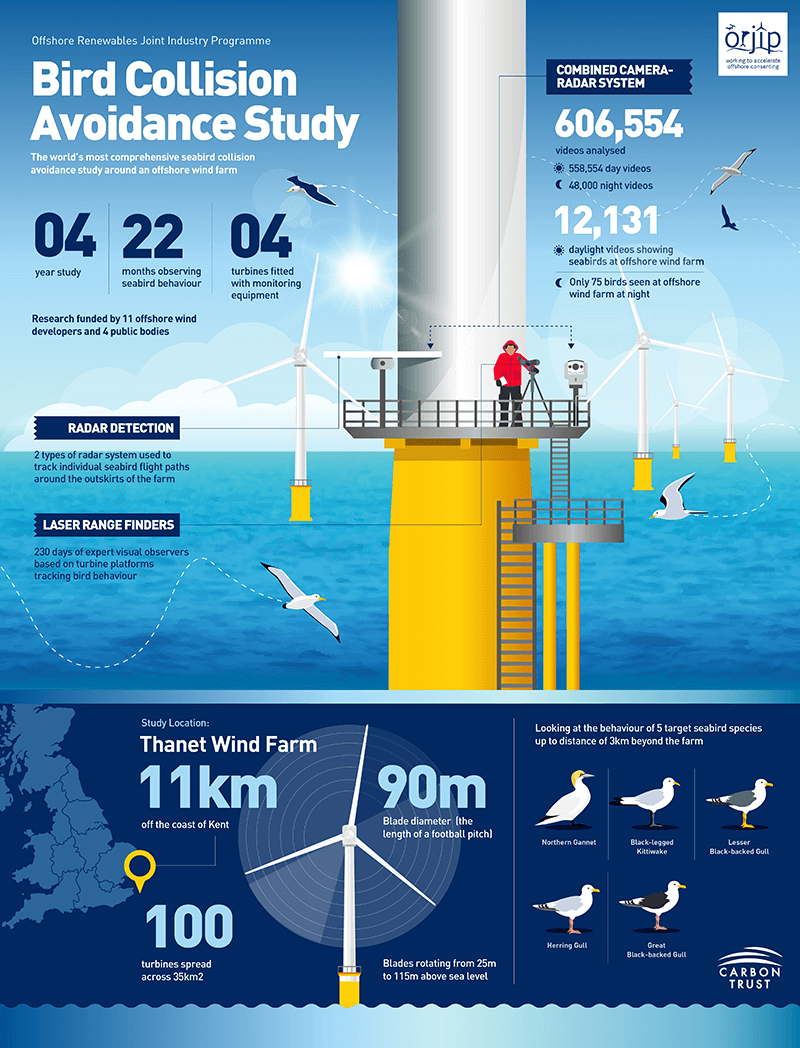The Offshore Renewables Joint Industry Programme (ORJIP) has released findings from the world’s most comprehensive investigation into seabird behavior and collision risk around offshore wind farms. The Bird Collision Avoidance Study is the first of its kind employing a multi-sensor monitoring system, combining human observer-based tracking with a system that automatically recorded seabird movements, at a working offshore wind farm in the English Channel. Radars were also used to record data 24 hours a day for two years.
The multimillion pound, collaborative study was commissioned by 11 leading offshore wind developers, The Crown Estate, The Crown Estate Scotland and Marine Scotland, was supported with funding from the UK Government and was managed by the Carbon Trust. The project was developed and run with the support and advice from the UK and Northern Europe’s leading ornithologists and environmental advisors such as Natural England and RSPB.

The project data is publically available via The Crown Estate’s data sharing platform the Marine Data Exchange. Download the report here.
During the two years of fieldwork, a significant number of videos were recorded at a representative area of Vattenfall’s Thanet offshore wind farm, one of the largest in UK waters. This resulted in the analysis of over 600,000 videos, of which only 12,131 contained evidence of bird activity and only six collisions with turbines were observed.The analysis revealed that collision risk of seabirds was less than half of what would be expected based on current understanding. During the study seabirds were observed to exhibited avoidance behavior and change their flight path to avoid the turbines.
“Today marks the result of four years of collaborative work from a range of stakeholders, all focused on bridging the gap between the theoretical and real understanding of how birds behave around an operational offshore wind farm,” said Jan Matthiesen, Director Offshore Wind at the Carbon Trust. “In March 2018, offshore wind generated 12% of the UK’s total energy, its highest contribution to date. ORJIP Offshore Wind has been designed to help contribute to the environmental evidence base to pave the way for a sustainable rollout of UK offshore wind. This study marks a significant step forward on this journey.”
To obtain planning consent for an offshore wind development the planning inspectorate needs to consider the risk of environmental impacts, as well as any mitigation measures proposed by a developer. The developer needs to provide evidence of how seabirds will behave within and around the farm. In order to quantify bird collision risk with turbines, collision risk models (CRM) are used to estimate this impact. Although extensive studies have looked at migratory patterns and behavior of seabirds around offshore wind farms, until now there was only limited evidence to substantiate their actual behavior.
The conclusions from this research on collision risk will allow better informed wind farm design and consent decisions just as the next generation of more powerful offshore turbines are being tested and manufactured. As a result the research will support UK Government plans to rapidly and sustainably grow the offshore wind sector by 2030.
The research was designed to generate robust, empirical evidence on the levels of avoidance behaviour and collisions to improve collision risk models. This will provide greater certainty on the true impact of offshore wind farms on seabirds and the mitigation measures required.
“This pioneering study, hosted at Vattenfall’s Thanet Offshore Wind Farm, is a significant step forward in our understanding of the way in which seabirds avoid offshore wind turbines, and comes at a crucial time as the next generation of wind turbines are designed and developed,” said Piers Guy, UK Country Manager, Vattenfall. “This research will support UK Government plans to rapidly and sustainably grow the offshore wind sector by 2030.”
Filed Under: News




